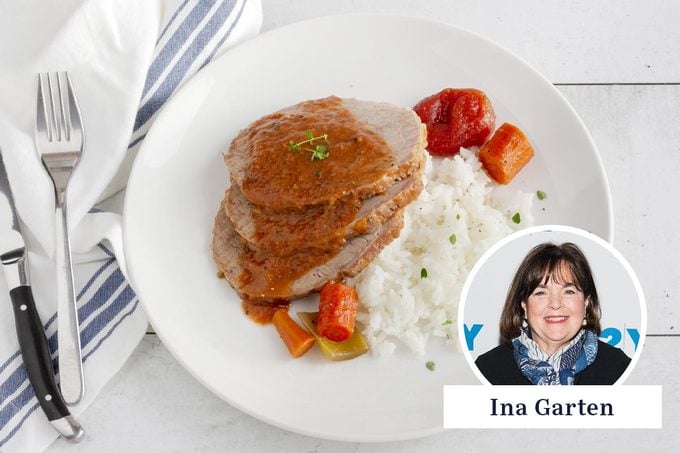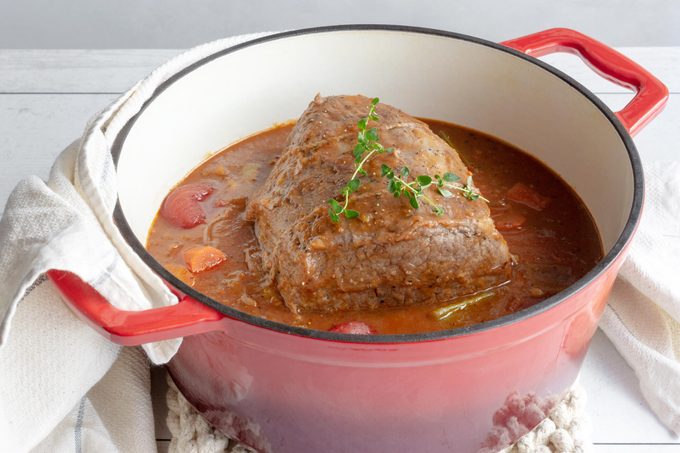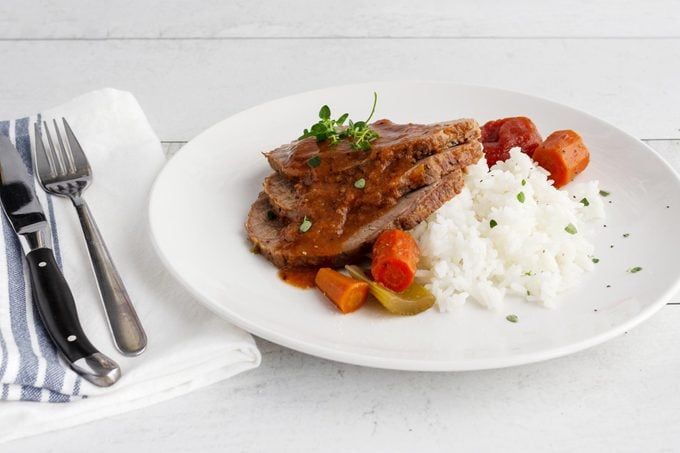Ina Garten’s Pot Roast Recipe Proves That She’s the Queen of the Kitchen
Updated: Apr. 11, 2023
Ina Garten's recipe for 'Company Pot Roast' is so good, you might not want to share with your guests.
Thank you, Ina Garten, for yet again turning an ordinary recipe into something exceptional. Her overnight mac and cheese is flavorful, creamy and cheesy. This homestyle meat loaf is juicy and full of diced, caramelized onions. And now that I’ve made the official Ina Garten pot roast recipe, I’m an even bigger fan of her elevated takes on classic dishes.
Many of the steps in Ina’s pot roast recipe will look familiar, such as searing the outside of the roast and simmering it with a mixture of vegetables and red wine. However, she builds more flavor into the sauce with ingredients like plum tomatoes, leeks, several cloves of garlic and a splash of Cognac. Ina also incorporates a few tricks to thicken the sauce into a rich and flavorful gravy. One is to coat the chuck roast in flour before searing it, to create a browned crust. Another is to puree half of the cooking liquid and vegetables before simmering the sauce.
The finished dish has slices of beautifully tender pot roast with plenty of thick, savory gravy to spoon over the top.
How to Make Ina Garten’s Pot Roast

The Barefoot Contessa’s recipe for Company Pot Roast needs about 2-1/2 hours in the oven, as well as the prep time beforehand. The recipe makes 8-10 servings.
Ingredients
- 4-5 pound prime boneless beef chuck roast, tied
- 2 tablespoons plus 2 teaspoons salt, divided
- 4 teaspoons black pepper, divided
- All-purpose flour (2 tablespoons for the sauce, plus enough to coat the outside of your roast)
- 1/4 cup olive oil, divided
- 2 cups chopped carrots
- 2 cups chopped yellow onions
- 2 cups chopped celery
- 2 cups chopped leeks (2-4 whole leeks, white and light green parts)
- 5 large cloves of garlic, peeled and crushed
- 2 cups Burgundy or other good red wine
- 2 tablespoons Cognac or brandy
- 28 ounces whole plum tomatoes in puree
- 1 cup chicken stock (homemade chicken stock, if possible)
- 1 chicken bouillon cube
- Piece of kitchen twine
- 3 stems fresh thyme
- 2 stems fresh rosemary
- 1 tablespoon unsalted butter, softened
Editor’s Tip: Here’s how to make sure your leeks are clean.
Directions

Step 1: Prepare the roast
Preheat the oven to 325°F. Have ready a large Dutch oven. Use paper towels to pat the chuck roast dry on all sides. Sprinkle 1 tablespoon of salt and 1-1/2 teaspoons of black pepper over the meat and rub them evenly over the surface. Scoop some all-purpose flour onto a large plate; roll the roast in the flour to dredge the entire surface, including the ends.
Step 2: Sear the meat
Heat two tablespoons of olive oil in the Dutch oven over medium heat. Place the roast in the pot; sear it for several minutes, then lift and turn the roast to sear the next side. Continue until the entire surface and ends have been browned. Lift the roast out, set it on a large plate and hold it aside.
Step 3: Sauté the vegetables
Add the remaining olive oil to the Dutch oven, then add in the chopped carrots, onions, celery, leeks and garlic. Sprinkle in 1 tablespoon of salt and 1-1/2 teaspoons of pepper. Cook the vegetables over medium heat for 10-15 minutes, stirring them occasionally, until they’re tender.
Step 4: Add the tomatoes, herbs and liquids
Pour the red wine and Cognac into the pot with the vegetables, and increase the heat to bring the liquids to a boil. Scrape the bottom of the pot with a wooden spoon to loosen the browned bits. Add in the plum tomatoes with puree, chicken stock, bouillon cube, 2 teaspoons of salt and 1 teaspoon of pepper. Tie the thyme and rosemary stems together with the kitchen twine; drop the bundle into the pot.
Step 5: Put the pot roast in the oven
Nestle the chuck roast in the Dutch oven, and spoon some of the cooking liquids over the top. Bring the liquids back to a boil and then cover the pot. Place the roast in the preheated oven for an hour—after this, reduce the heat to 250°. Continue cooking the pot roast for another 1-1/2 hours. When done, the meat should be fork-tender with an internal temperature of 160°. Remove the pot from the oven.
Step 6: Finish the sauce
Lift the roast out of the pot and set it on a cutting board. Remove the bundle of herbs and discard. Skim off as much fat as possible from the surface of the sauce. Scoop half of the sauce and the vegetables into a blender or a food processor with a blade. Process the sauce and veggies until they’re completely smooth. Pour this puree back into the pot and move the pot back onto the burner. Bring the sauce to a simmer over low heat.
Use a fork to mash together 2 tablespoons of flour with the tablespoon of softened butter in a small dish. Stir the flour-butter mixture into the sauce and simmer the sauce for 2 minutes, stirring occasionally, until the sauce is thickened. Taste the sauce and add more salt or pepper if needed.
Step 7: Slice the pot roast and serve
Remove and discard the strings from the pot roast. Use a sharp knife to slice the pot roast into thin slices. Serve slices of warm pot roast with the sauce spooned over the top.
Here’s What I Thought

What a perfect pot roast! It was everything I could have wanted: tender slices of meat with a thick, rich sauce that had so much flavor. My kitchen smelled incredible as this pot roast simmered away in the oven, and Ina’s recipe is certainly worth the wait. My husband and I enjoyed our pot roast and plenty of sauce over cooked rice; other sides to pair with this dish include buttery mashed potatoes, egg noodles and homemade biscuits.
Try other root veggies with this pot roast, such as parsnips or sweet potatoes. Mushrooms would also be a great addition to this dish.
Tips for Making Ina’s Pot Roast
- Although this recipe isn’t difficult to make, it does have a long list of ingredients. Take a tip from restaurant chefs and practice your mise en place, or “everything in its place.” Have all the vegetables chopped, spices, flour and liquids measured out and your kitchen tools ready before starting the recipe.
- This recipe makes a lot of sauce, so you may have some leftovers. The sauce is tasty warmed up and served over baked potatoes or cooked pasta. Another way we enjoyed the sauce was spooned over slices of toasted sourdough, with grated cheddar sprinkled over the top and broiled until melted.
